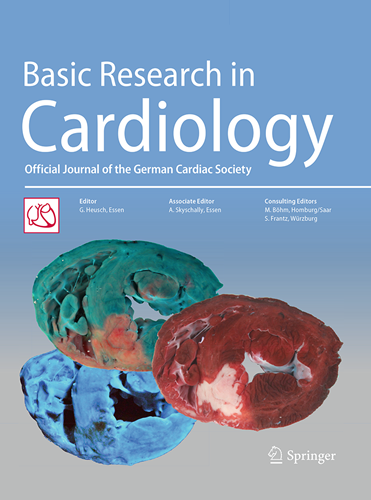Potassium as an electro-metabolic signal for local coronary vasodilation.
IF 8
1区 医学
Q1 CARDIAC & CARDIOVASCULAR SYSTEMS
引用次数: 0
Abstract
This study tested the hypothesis that K+ serves as an in vivo signal coupling coronary blood flow with the oxidative requirements of the myocardium. Experiments were performed in swine in which coronary parameters and arterial and coronary venous [K+] were measured under baseline conditions, during exogenous administration of K+ (1-5 mM; n = 4), during increases in myocardial oxygen consumption (MVO2) to dobutamine (n = 7) and exercise (n = 6), alterations in coronary perfusion pressure (CPP; n = 8), and systemic hypoxemia (PaO2 to ~ 30 mmHg; n = 7). Exogenous intracoronary K+ increased blood flow (~ 20%) in direct proportion to the coronary venous [K+] up to the lethal limit of ~ 10 mM. Dobutamine increased coronary flow and MVO2 ~ threefold but the coronary venous-arterial [K+] gradient (i.e., a surrogate index of myocardial release of K+ into the coronary circulation) did not change. Similarly, exercise increased coronary flow and MVO2 ~ 2.5-fold without a change in the coronary venous-arterial [K+] gradient. The coronary venous-arterial [K+] gradient did not change over the CPP range of 140-40 mmHg. Hypoxemia increased coronary blood flow ~ twofold and coronary vascular resistance was weakly associated with < 0.5 mM change in the coronary venous-arterial [K+] gradient. Intracoronary glibenclamide dose-dependently (1-3 mg/min; n = 4) increased coronary resistance but did not affect the coronary venous-arterial [K+] gradient. Intracoronary pinacidil dose-dependently (0.3-3.0 µg/kg/min; n = 3) increased coronary blood flow but did not affect the coronary venous-arterial [K+] gradient. Similarly, intravenous glibenclamide (3 mg/kg; n = 6) increased coronary resistance but did not affect the coronary venous-arterial [K+] gradient in exercising swine. These findings fail to support the concept that myocardial interstitial [K+] couples coronary blood flow to MVO2 during physiologic increases in cardiac work or when oxygen delivery is constrained.钾作为局部冠状动脉血管舒张的电代谢信号。
本研究验证了K+作为体内信号耦合冠状动脉血流量与心肌氧化需求的假设。实验在猪体内进行,在基线条件下,外源性K+ (1-5 mM;n = 4),在心肌耗氧量(MVO2)对多巴酚丁胺的增加(n = 7)和运动(n = 6)期间,冠状动脉灌注压(CPP;n = 8),全身性低氧血症(PaO2 ~ 30 mmHg;n = 7)。外源性冠状动脉内K+与冠状静脉[K+]成正比增加血流量(~ 20%),达到致死极限~ 10 mM。多巴酚丁胺使冠状动脉血流和MVO2增加3倍,但冠状静脉-动脉[K+]梯度(即心肌向冠状动脉循环释放K+的替代指标)没有改变。同样,运动使冠状动脉血流和MVO2增加2.5倍,而冠状静脉-动脉[K+]梯度没有变化。在140-40 mmHg的CPP范围内,冠状静脉-动脉[K+]梯度没有变化。低氧血症使冠状动脉血流量增加约2倍,冠状血管阻力与< 0.5 mM的冠状静脉-动脉[K+]梯度变化呈弱相关。冠状动脉内格列苯脲剂量依赖性(1- 3mg /min;n = 4)冠脉阻力增加,但不影响冠脉静脉-动脉[K+]梯度。冠状动脉内pinacidil剂量依赖性(0.3-3.0µg/kg/min;n = 3)冠脉血流量增加,但不影响冠状静脉-动脉[K+]梯度。同样,静脉注射格列本脲(3mg /kg;n = 6)增加了运动猪的冠状动脉阻力,但不影响冠状静脉-动脉[K+]梯度。这些发现不支持心肌间质[K+]在心脏工作生理性增加或氧输送受限时冠状动脉血流到MVO2的概念。
本文章由计算机程序翻译,如有差异,请以英文原文为准。
求助全文
约1分钟内获得全文
求助全文
来源期刊

Basic Research in Cardiology
医学-心血管系统
CiteScore
16.30
自引率
5.30%
发文量
54
审稿时长
6-12 weeks
期刊介绍:
Basic Research in Cardiology is an international journal for cardiovascular research. It provides a forum for original and review articles related to experimental cardiology that meet its stringent scientific standards.
Basic Research in Cardiology regularly receives articles from the fields of
- Molecular and Cellular Biology
- Biochemistry
- Biophysics
- Pharmacology
- Physiology and Pathology
- Clinical Cardiology
 求助内容:
求助内容: 应助结果提醒方式:
应助结果提醒方式:


